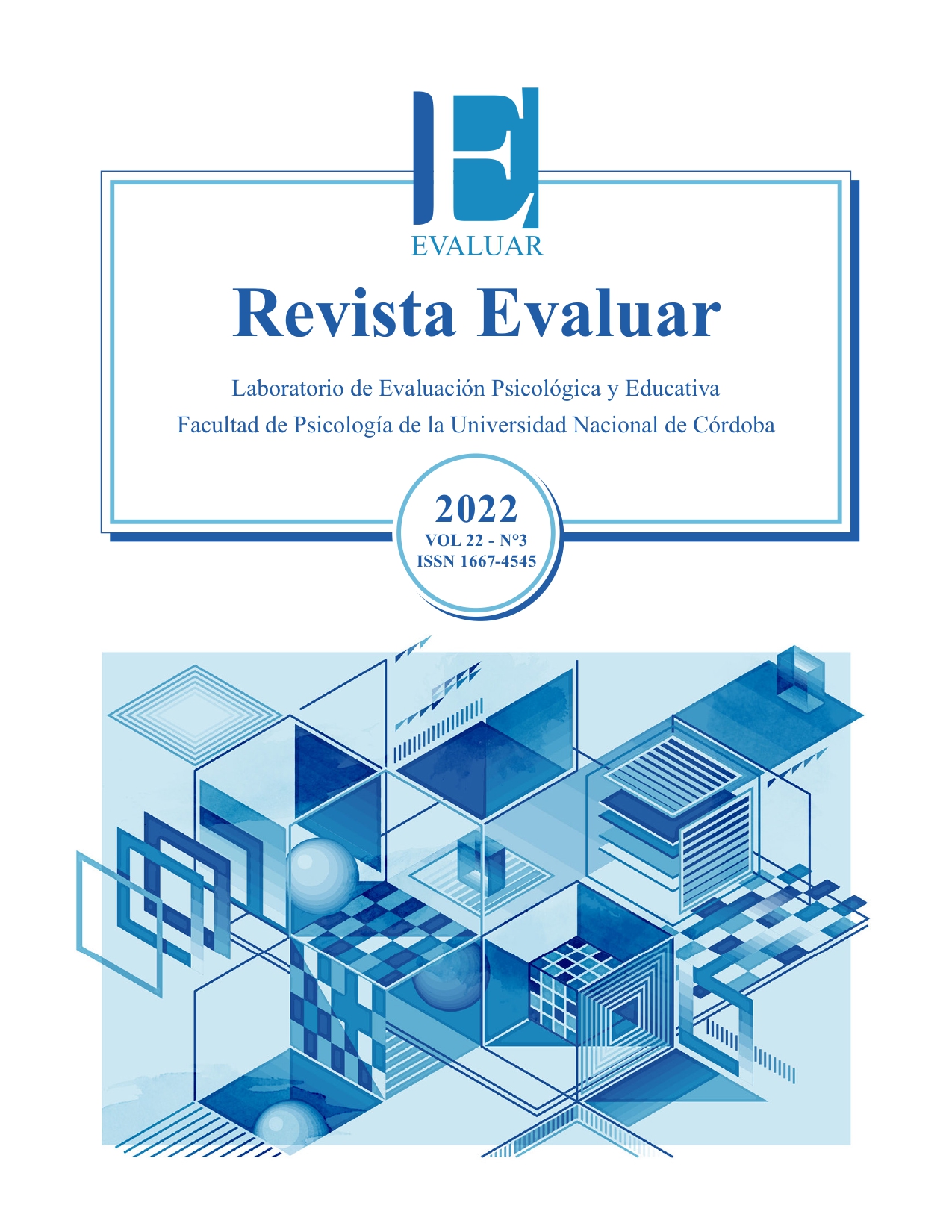Construction of the Brief Scale on HIV Stigmatization in the General Population of Buenos Aires
DOI:
https://doi.org/10.35670/1667-4545.v22.n3.39988Keywords:
HIV, stigma, scale, CABA, factorial analysisAbstract
Stigmatization has accompanied the HIV pandemic since its origins, having negative consequences on the health of people with HIV and discouraging regular testing in the general population. Any design, monitoring, and readjustment of policies aimed at reducing stigmatization towards HIV require having rigorous instruments for its measurement. The objective of this study was to build and validate a Brief Scale on HIV Stigmatization (BESEHIV) in a representative sample of the Autonomous City of Buenos Aires (CABA), taking into account its linguistic particularities. Four hundred (n = 400) participants between 18 and 60 years old were surveyed on public roads in a quota design to achieve representativeness of gender, age, level of education, and socioeconomic level. The BESE-HIV was made up of nine items and showed very good levels of reliability and evidence of adequate internal and external validity, which indicates it is a promising instrument.
Downloads
References
Alaminos-Chica, A., & Castejón-Costa, J. L. (2006). Elaboración, análisis e interpretación de encuestas, cuestionarios y escalas de opinión. Alicante, España: Marfil.
Ato, M., López, J. J., & Benavente, A. (2013). Un sistema de clasificación de los diseños de investigación en psicología. Anales de Psicología, 29(3), 1038-1059. doi: 10.6018/analesps.29.3.178511
Bilder, P. (2010). “Una visita inesperada”. Primeros años del SIDA en la Argentina (1981-1984). En H. Vessuri, P. Kreimer, A. Arellano & L. Sanz-Méndez (Eds.), Conocer para transformar: Producción y reflexión sobre ciencia, tecnología e innovación en Iberoamérica (pp. 35-53). Caracas: UNESCO-IESALC.
Contigiani, M. F., Sánchez-López, J. M., Laurito, M., Vergara, A., Lugo, N., & Cuenya, L. (2022). Conocimiento sobre VIH-sida en población general de la Ciudad Autónoma de Buenos Aires y su vinculación con variables sociodemográficas. PSocial. Revista de Investigación en Psicología Social, 8(1), s.p. Recuperado de https://publicaciones.sociales.uba.ar/index.php/psicologiasocial/article/view/7392/6539
Decreto 297/2020. Aislamiento Social Preventivo y Obligatorio. Recuperado de https://www.boletinoficial.gob.ar/detalleAviso/primera/227042/20200320
Delgado, R. (2011). Características virológicas del VIH. Enfermedades Infecciosas y Microbiología Clínica, 29(1), 58-65. doi: 10.1016/j.eimc.2010.10.001
Earnshaw, V. A., & Chaudoir, S. R. (2009). From Conceptualizing to Measuring HIV Stigma: A Review of HIV Stigma Mechanism Measures. AIDS and Behavior, 13(6), 1160-1177. doi: 10.1007/s10461-009-9593-3
Earnshaw, V. A., Smith, L. R., Chaudoir, S. R., Amico, K. R., & Copenhaver, M. M. (2013). HIV Stigma Mechanisms and Well-Being among PLWH: A Test of the HIV Stigma Framework. AIDS and Behavior, 17(5), 1785-1795. doi: 10.1007/s10461-013-0437-9
Eisinger, R. W., Dieffenbach, C. W., & Fauci, A. (2019). HIV viral load and transmissibility of HIV infection. Undetectable equals untransmittable. JAMA, 321(5), 451-452. doi: 10.1001/jama.2018.21167
Elosua, P., & Egaña, M. (2020). Psicometría aplicada. Guía para el análisis de datos y escalas con Jamovi. Bilbao: Universidad del País Vasco.
Escobar-Pérez, J., & Cuervo-Martínez, A. (2008). Validez de contenido y juicio de expertos: Una aproximación a su utilización. Avances en Medición, 6, 27-36. doi: 10.32870/ap.v9n2.993
Esteban, C., González-Rivera, J. A., Francia-Martínez, M., & Lespier, Z. (2020). Desarrollo de instrumentos para medir actitudes hacia la comunidad trans: Análisis preliminares. Revista Evaluar, 20(1), 68-82. doi: 10.35670/1667-4545.v20.n1.28486
Ferrando, P. J., & Lorenzo-Seva, U. (2014). El análisis factorial exploratorio de los ítems: Algunas consideraciones adicionales. Anales de Psicología, 30(3), 1170-1175. doi: 10.6018/analesps.30.3.199991
Ferrando, P. J., & Lorenzo-Seva, U. (2017). Program FACTOR at 10: Origins, development and future directions. Psicothema, 29(2), 236-240. doi: 10.7334/psicothema2016.304
Fundación Huésped. (2012). Percepciones y experiencias sobre estigma y discriminación en poblaciones trans, HSH, y usuarios de drogas. Buenos Aires: Autor. Recuperado de https://www.huesped.org.ar
Fuster-Ruiz, M. J., Molero, F., Gil de Montes, L., Agirrezabal, A., & Vitoria, A. (2013). HIV- and AIDS-related stigma: Psychosocial aspects in a representative Spanish sample. Spanish Journal of Psychology, 16(e30), 1-8. doi: 10.1017/sjp.2013.52
Genberg, B. L., Kawichai, S., Chingono, A., Sendah, M., Chariyalertsak, S., Konda, K. A., & Celentano, D. D. (2008). Assessing HIV/AIDS Stigma and Discrimination in Developing Countries. AIDS and Behavior, 12(5), 772-780. doi: 10.1007/s10461-007-9340-6
Goffman, E. (1963). Estigma. La identidad deteriorada. Buenos Aires-Madrid: Amorrortu.
Green, W. C. (2007). A history of AIDS: Looking back to see ahead. European Journal of Immunology, 37(1), S94-102. doi: 10.1002/eji.200737441
Grinsztejn, B., Housseinipour, M. C., Ribaudo, H. J., Swindelles, S., Eron, J., … & Cohen, M. S. (2014). Effects of early versus delayed initiation of antiretroviral treatment on clinical outcomes of HIV-1 infection: Results from the phase 3 HPTN 052 randomised controlled trials. The Lancet, 14(4), 281-290. doi: 10.1016/S1473-3099(13)70692-3
Hair, J. E., Black, W. C., Babin, B. J., Anderson, R. E., & Tatham R. L. (2010). Multivariate Data Analysis (6th ed.). Upper Saddle River, NJ: Pearson-Prentice Hall.
Hamra, M., Ross, M. W., Orrs, M., & D’Agostino, A. (2006). Relationship between expressed HIV/AIDS-related stigma and HIV-beliefs/knowledge and behaviour in families of HIV infected children in Kenya. Tropical Medicine & International Health, 11(4), 513-527. doi: 10.1111/j.1365-3156.2006.01583.x
Índice de Estigma y Discriminación hacia las Personas con VIH en Argentina 2.0 (2020). Recuperado de https://www.undp.org/es/argentina/publicaciones/indice-de-estigma-y-discriminacion
Instituto Nacional de Estadísticas y Censos de la República Argentina (2010). Censo 2010. Recuperado de https://www.indec.gob.ar/indec/web/Nivel4-Tema-2-41-135
Jones, E. E., Farina, A., Hestrof, A. H., Markus, H., Miller, D. T., & Scott, R. A. (1984). Social stigma: The psychology of marked relationships. New York: Freeman.
Kaiser, H. F. (1960). The application of electronic computers to factor analysis. Educational and Psychological Measurement, 20, 141-51.doi:
1177/001316446002000116
Kalichman, S. C., Simbayi, L. C., Jooste, S., Toefy, Y., Cain, D., Cherry, C., & Kagee, A. (2005). Development of a brief scale to measure AIDS-related stigma in South Africa. AIDS and Behavior, 9(2), 135-43. doi: 10.1007/s10461-005-3895-x
Kurzban, R., & Leary, M. R. (2001). Evolutionary Origins of Stigmatization: The Functions of Social Exclusion. Psychological Bulletin, 127(2), 187-208. doi: 10.1037/0033-2909.127.2.187
Letshwenyo-Maruatona, S. B., Madisa, M., Boitshwarelo, T., George-Keliwe, B., Kingori, C., Ice, G., Bianco, J. A., Marape, M., & Haile, Z. T. (2019). Association between HIV/AIDS knowledge and stigma towards people living with HIV/AIDS in Botswana. African Journal of AIDS Research, 18(1), 58-64. doi: 10.2989/16085906.2018.1552879
Ley 27675. Ley Nacional de Respuesta Integral al VIH, Hepatitis Virales, Otras Infecciones de Transmisión Sexual (ITS) y Tuberculosis (TBC) (18 de julio de 2022). Recuperado de https://www.argentina.gob.ar/justicia/derechofacil/leysimple/salud/respuesta-integral-al-vih-hepatitis-virales-otras-infecciones
Li, T., Zhu, S., & Ogihara, M. (2006). Using discriminant analysis for multi-class classification: An experimental investigation. Knowledge and Information Systems, 10, 453-472. doi: 10.1007/s10115-006-0013-y
Llorent-Segura, S., Ferreres-Traver, A., Hernández-Baeza, A., & Tomás-Marco, I. (2014). El análisis factorial exploratorio de los ítems: Una guía práctica, revisada y actualizada. Anales de Psicología, 30(3), 1151-1169. doi: 10.6018/analesps.30.3.199361
Logie, C., & Gadalla, T. M. (2009). Meta-analysis of health and demographic correlates of stigma towards people living with HIV. AIDS Care, 21, 742-753. doi: 10.1080/09540120802511877
Mandell, L. N., Rodriguez, V. J., de La Rosa, A., Abbamonte, J. M., Sued, O., Cecchini, D., ... Grupo de estudio COPA SIDA y Comportamiento. (2019). Suicidal ideation among adults re-engaging in HIV care in Argentina. AIDS and Behavior, 23(6), 3427-3434. doi: 10.1007%2Fs10461-019-02526-4
Martínez-Arias, R. (2005). Psicometría: Teoría de los Test Psicológicos y Educativos. Madrid: Síntesis Psicológica.
Ministerio de Salud. (2020). Boletín N° 37. Respuesta al VIH y las ITS en la Argentina sobre el VIH, sida e ITS en la Argentina, 23. Recuperado de https://bancos.salud.gob.ar/sites/default/files/2020-11/Boletin%20VIH%202020%20final%20V2.pdf
Molero-Alonso, F. (2007). Prejuicio y estigma: Efectos y posibles soluciones. En J. F. Morales-Domínguez, M. C. Moya-Morales, E. Gaviria-Stewart & I. Cuadrado-Guiraldo (Coords.), Psicología Social, Tercera Edición (pp. 619-640). Madrid: McGraw Hill.
Morales, P. (2006). Medición de actitudes en psicología y educación. Construcción de escalas y problemas metodológicos. Madrid: Universidad Pontificia Comillas de Madrid.
Ogden, J., & Nyblade, L. (2005). Common at its core: HIV-related stigma across contexts. International for Research on Women (ICRW).
Pecheny, M. (2008). Estudio sobre la situación social de las Personas Viviendo con VIH en la Argentina. Buenos Aires: UBATEC.
Pérez, E. R., & Medrano, L. A. (2010). Análisis factorial exploratorio: Bases conceptuales y metodológicas. Revista Argentina de Ciencias del Comportamiento, 2(1), 58-66. Recuperado de https://dialnet.unirioja.es/servlet/articulo?codigo=3161108
Radusky, P. D., Zalazar, V., Aristegui, I., Sued, O., & Mikulic, I. M. (2018). Avances en la construcción del Inventario de Estigma relacionado con el VIH (IEVIH) en Buenos Aires, Argentina. Psicodebate, 17(2), 7-24. doi: 10.18682/pd.v17i2.669
Richaud de Minzi, M. C. (2008). Nuevas tendencias en psicometría. Revista Evaluar, 8, 1-19. doi: 10.35670/1667-4545.v8.n1.501
Rodger, A. J., Cambiano, V., Bruun, T., Vernazza, P., Collins, S., … & PARTNER Study Group. (2019). Risk of HIV transmission through condomless sex in serodifferent gay couples with the HIV-positive partner taking suppressive antiretroviral therapy (PARTNER): Final results of a multicentre, prospective, observational study. Lancet, 15(393), 2428-2438. doi: 10.1016/S0140-6736(19)30418-0
Rodger, A. J., Cambiano, V., Bruun, T., Vernazza, P., Collins, S., … & PARTNER Study Group. (2016). Sexual activity without condoms and risk of HIV transmission in serodifferent couples when the HIV-positive partner is using suppressive antiretroviral therapy. JAMA, 316(2), 171-181. doi: 10.1001/jama.2016.5148
SAIMO. (2020). Anticipo NSE. Primer Trimestre 2020. Recuperado de https://www.saimo.org.ar
Schimmack, U. (2020). A meta-psychological perspective on the decade of replication failures in social psychology. Canadian Psychology/Psychologie Canadienne, 61(4), 364-376. Recuperado de https://psycnet.apa.org/doi/10.1037/cap0000246
Schütz, H., & Six, B. (1996). How strong is the relationship between prejudice and discrimination? A meta-analytic answer. International Journal of Intercultural Relations, 20(3-4), 441-462. doi: 10.1016/0147-1767(96)00028-4
Stephenson, R. (2009). Community factors shaping HIV-related stigma among young people in three African countries. AIDS Care, 21(4), 403-410. doi: 10.1080/09540120802290365
Sweeney, S. M., & Vanable, P. A. V. (2016). The association of HIV-related stigma to HIV medication adherence: A systematic review and synthesis of the literature. AIDS and Behavior, 20(1), 29-50. doi: 10.1007/s10461-015-1164-1
UNAIDS. (2019). Global AIDS Update. Recuperado de https://www.unaids.org
Van Rie, A., Sengupta, S., Pungrassami, P., Balthip Q., Choonuan, S., … & Chongsuvivatwong, V. (2008). Measuring stigma associated with tuberculosis and HIV⁄AIDS in southern Thailand: Exploratory and confirmatory factor analyses of two new scales. Tropical Medicine and International Health, 13(1), 21-30. doi: 10.1111/j.1365-3156.2007.01971.x
Zelaya, C. E., Sivaram, S., Johnson, S. C., Srikrishnan, A. K., Solomon, S., & Celentano, D. D. (2008). HIV/AIDS stigma: Reliability and validity of a new measurement instrument in Chennai, India. AIDS and Behavior, 12(5), 781-788. doi: 10.1007/s10461-007-9331-7
Downloads
Published
How to Cite
Issue
Section
License
Copyright (c) 2023 Lucas Cuenya, Nancy Lugo, María Florencia Contigiani, Jorge Mario Sánchez-López, Leila Castro, Pablo Radusky, Sebastián Gabini

This work is licensed under a Creative Commons Attribution 4.0 International License.
Revista Evaluar aplica la Licencia Internacional de Atribuciones Comunes Creativas (Creative Commons Attribution License, CCAL). Bajo esta licencia, los autores retienen la propiedad de copyright de los artículos pero permiten que, sin que medie permiso de autor o editor, cualquier persona descargue y distribuya los artículos publicados en Evaluar. La única condición es que siempre y en todos los casos se cite a los autores y a la fuente original de publicación (i.e. Evaluar). El envío de artículos a Evaluar y la lectura de los mismos es totalmente gratuito.




_(3).jpg)



.jpg)



